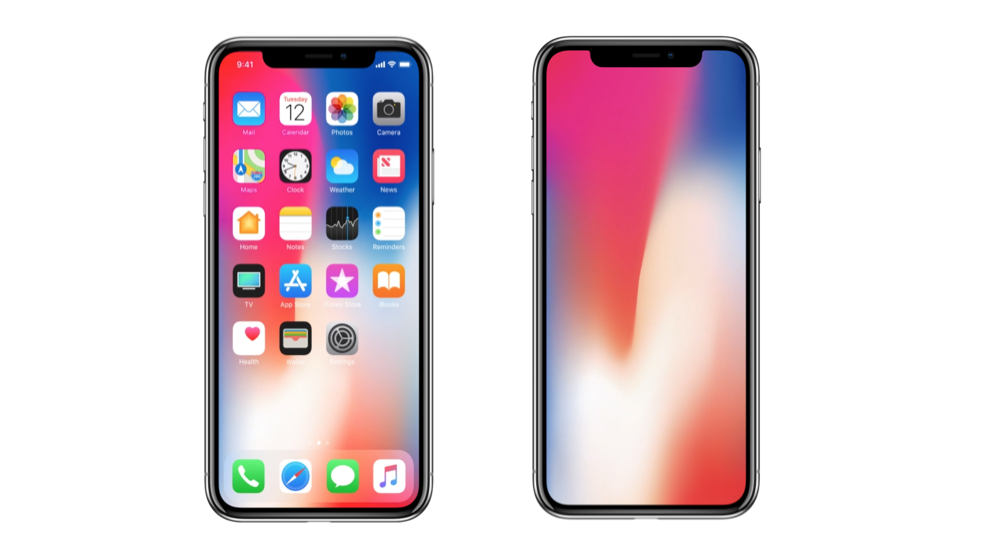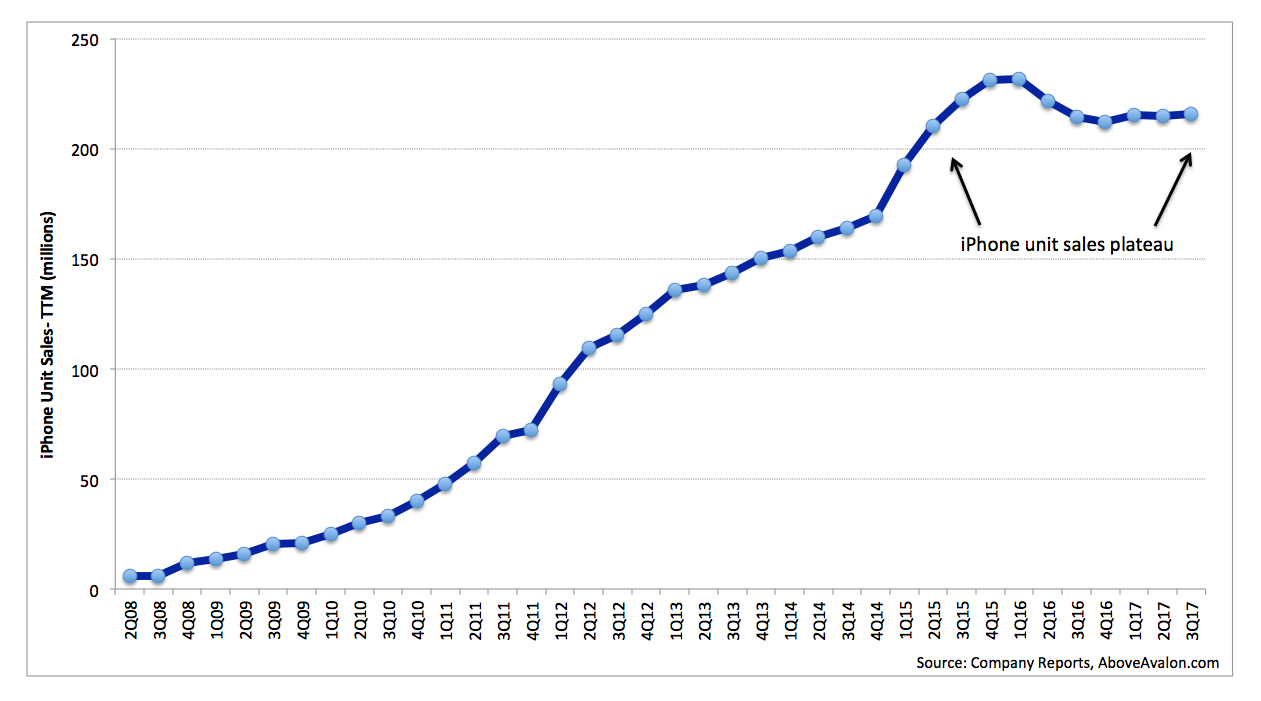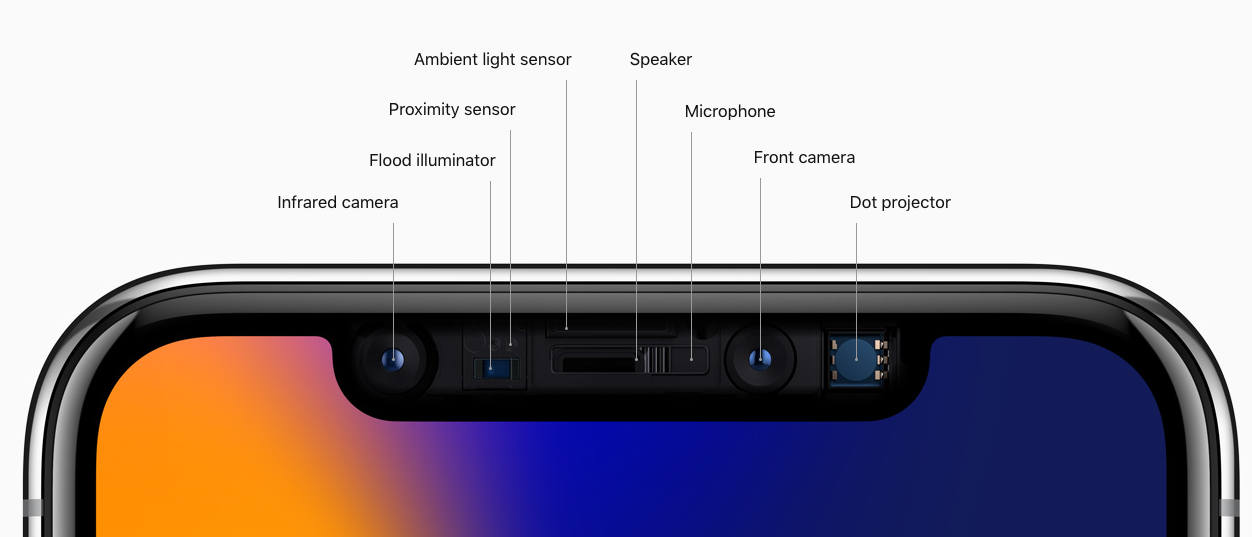iPhone Courage
iPhone pricing has garnered more attention in recent months than any other Apple topic. However, pricing is not the most important variable impacting the iPhone business. With iPhone X, Apple is taking what previously worked with iPhone and throwing it away in an effort to create a better user experience. For Apple to take this much risk with the product responsible for the vast majority of its cash generation and new user growth is noteworthy.
iPhone X
During its inaugural event at Steve Jobs Theater last month, Apple unveiled three flagship iPhones. Management dedicated 20 minutes of stage time to iPhone 8 and 8 Plus, models clearly positioned within the existing iPhone paradigm. Attention then turned to iPhone X, which garnered nearly twice as much stage time. While the "X" stands for ten, it could have very well stood for extreme. iPhone X will be the most radical iPhone Apple has sold to date. The home button has been removed to fit a larger screen in a smaller form factor. This change, which was years in the making, ushers in a completely new iPhone experience. Users will have to retrain their finger reflex to not press the bottom of the screen and instead, get used to swipes. In addition, the removal of fingerprint recognition in favor of facial recognition represents a very big change in how we will use iPhone. A strong argument can be made that removing the home button is the single-biggest change Apple has made to iPhone. The sheer amount of risk found in the move is being grossly underestimated.
iPhone Strategy
Apple is launching iPhone X at a critical juncture for the iPhone business. A slowing upgrade rate among existing iPhone users has led to overall unit sales plateauing, as highlighted in Exhibit 1.
Exhibit 1: iPhone Unit Sales (Trailing Twelve Months)
Despite weakening sales growth trends, Apple is still selling more than 200M iPhones per year, bringing in $140B of revenue and $60B of gross profit. In addition, the iPhone installed base grew by approximately 110 million users in 2017. iPhone remains Apple's most effective tool for grabbing new users.
Apple's iPhone strategy can be broken into three parts:
- Pricing
- Product marketing
- Design
While much of the attention has been focused on Apple's move at the high-end of the iPhone pricing spectrum, the company is making just as interesting of a change at the low-end. Apple is following a consumer segmentation strategy. Management is cutting iPhone pricing at the low-end to improve accessibility. The $399 iPhone price floor that had been in existence for years was shattered last month. A $350 iPhone SE is the lowest-priced "new" iPhone Apple has sold to date. Management's decision to continue selling iPhone 6s and 6s Plus, and even iPhone 6 in select markets, positions additional SKUs for customers focused on value and price. Meanwhile, at the other end of the pricing spectrum, Apple is running with higher-priced models targeting consumers who value the latest and greatest technology.
Underlying this pricing dynamic is a product marketing strategy focused on positioning the iPhone as the best camera people have ever owned. The dual-camera system found in iPhone 7 Plus is one of the more noteworthy iPhone features in years. With iPhone 8 Plus and iPhone X, Apple introduced Portrait Lighting, which adds a new element to Portrait mode. Apple then went further to include Portrait mode and Portrait Lighting on the iPhone X front-facing camera.
Apple saw how cameras are becoming much more than memory capture tools. Cameras are turning into smart eyes powering the dawn of the augmented reality era. Apple spent years dedicating resources to the effort and is now at the point where iPhone cameras are being powered by Apple silicon. This provides Apple's cameras additional differentiation and the ability to stand out from peers.
Apple has seen quite a bit of success with its iPhone pricing and product marketing strategy over the years. However, these two variables are not the most important items impacting iPhone's evolution. Design, or the way consumers use the product, has a much larger impact on iPhone's future, and Apple is making big changes to how we will use iPhone going forward.
The Headphone Jack
iPhone X demonstrates how Apple is willing to move beyond legacy design constraints and thinking. The home button has come to represent safety for hundreds of millions of people. In just a few years, Touch ID and fingerprint recognition became universally accepted because of their connection with the convenient iPhone home button. Apple is taking this familiar design and throwing it out the window in an attempt to push the iPhone experience forward. Although Apple is confident consumers will embrace the changes, the confidence sure isn't a result of consumers demanding or wishing for these changes. Instead, Apple designers and engineers are throwing away legacy thinking in order come up with something new. Upon closer examination, Apple has previously demonstrated this willingness to let go of legacy design.
In September 2016, Apple unveiled iPhone 7 and 7 Plus. The two flagship models contained the typical assortment of new features and upgrades. However, one change stood out from the others. Apple removed the dedicated headphone jack despite no one having asked for such a move. Instead of including the traditional pair of EarPods in the box, Apple unveiled a new pair of EarPods that used the Lightning connector. In addition, Apple included a small adapter so that older headphones would connect with Lightning.
When explaining Apple's decision, Phil Schiller, Apple SVP worldwide marketing, said "it really comes down to one word: courage. The courage to move on, do something new that betters all of us."
To say that removing the headphone jack was a controversial decision would be an understatement. The mere thought of removing the dedicated headphone jack from smartphones drove the tech community up a wall with some declaring the move as "user hostile" and "stupid." Schiller's explanation for the removal did not sit well with many. Some referred to it as tone-deaf, and others used arrogance and greed to describe the situation. There were then some who thought Schiller should have said "courage of convictions" in order to better encapsulate his meaning.
In reality, Schiller was right in calling Apple's decision to remove the dedicated headphone jack courage. As it turns out, Apple displayed additional courage last month by removing the home button from iPhone X.
Courageous
The reason these iPhone design choices can be called courageous is that Apple is not afraid to risk sales in order to make technology more personal. It is not easy to take a product that is bringing in more than $140B of revenue per year and change the way people fundamentally use the device. While this situation may seem too self-centered to deserve being called courageous, iPhone is used by 800 million people. (The math behind my iPhone user base estimate is available for Above Avalon members here.) A design decision capable of improving or advancing the iPhone experience will have a tangible impact on many lives. It's not an exaggeration to say that society as a whole can benefit from these iPhone design choices. We are empowered by having a mobile computer in our pockets, and additional power will flow to users as smartphones evolve into augmented reality devices.
The headphone jack is one of a handful of examples of Apple displaying courage by taking what seemed to be working fine and throwing it away to improve the iPhone user experience.
- 30-pin dock connector removal
- Headphone jack removal
- Home button removal
These design choices share a few common traits:
- Deliberate. Apple doesn't make changes for the sake of making changes. Instead, the company is deliberate with its choices. A headphone jack is not removed in order to merely have iPhone 7 stand out from iPhone 6s. Instead, the move is an early step in Apple's long-term mission to remove wires from our lives. Schiller's inability to discuss the long-term goal found in removing the dedicated headphone jack is one reason his courageous comments came off as tone-deaf. A number of years and iPhone versions often have to pass before the motivation behind some of Apple's design decisions becomes clear.
- Decisive. Apple doesn't sit on the fence when it comes to design. One should not bet on a dedicated headphone jack returning to iPhone. In what is still a raw and polarizing topic for some, dedicated home buttons with fingerprint readers are on their way out over the coming years. Dedicated home buttons don't have a future at Apple.
- Design. All of these significant iPhone changes are made with design in mind. By removing the dedicated headphone jack and home button, Apple is changing the way we interact with iPhone. While some of these changes occur through a new user interface, other changes involve how we use iPhone in relation to other products. While the user experience change is less clear with some changes, such as Apple swapping the 30-pin dock connector with Lightning, other examples, like the home button removal, are much more apparent.
It's All About Design
Avoiding change out of fear of angering users or customers can cripple an otherwise successful product and company. Fear of throwing away design artifacts and legacy tendencies represents one of the biggest risks facing iPhone today. This is why design, and not pricing or product marketing, is the most important variable when thinking about iPhone's future.
Fear of embracing change would make it impossible for Apple to accomplish its long-term goal of making technology more personal. When it comes to iPhone, this goal manifests itself in a design that blends hardware and software. Apple's willingness to take big design bets allows iPhone to evolve over time. As buttons and ports are removed to make room for the latest camera, battery, and screen technology, iPhone morphs from a multi-touch computer into an augmented reality navigator controlled by glances and looks.
This behavior of killing off features, components, ports, and technology in an effort to push the user experience forward is a carryover of Apple's approach with the Mac. The difference this time around is that Apple is making these changes to a product that is used by 8x more users.
Samsung vs. Apple
Apple is not alone in pushing smartphone changes like removing a front-facing home button or dedicated headphone jack. In fact, making changes for the sake of change is relatively easy in the smartphone industry. The difficult part is leveraging these changes to push the user experience forward.
Samsung was able to beat Apple to market with an OLED smartphone lacking a front-facing home button. However, the difference in how Samsung and Apple leveraged these design changes is noteworthy. By removing the home button, both companies had to come up with an alternative to having a fingerprint reader positioned in a convenient location. Samsung chose to place the reader in a much more awkward location on the back of the device. Meanwhile, the company's facial recognition alternative ended up being a bust as it quickly became apparent it just wasn't as good as fingerprint recognition. It is tough to argue that the Samsung Galaxy user experience was improved with such changes. Instead, Samsung serves as an example of making changes for the sake of change.
Meanwhile, Apple is positioning Face ID as the alternative to having Touch ID and the home button. If done correctly, Apple will be the company to bring facial recognition as a form of biometric authentication to the masses. Based on the company's success with Touch ID, Apple deserves the benefit of the doubt that Face ID can follow suit and see massive customer acceptance. In fact, Apple's removal of the home button and embrace of Face ID will likely kick off a new era at the company involving facial recognition. It is only a matter of time before every Apple product with a camera has the TrueDepth camera system. Such a development may seem trivial, but it will lead to a new era of health monitoring to which we haven't even contemplated the implications yet.
TrueDepth camera system in iPhone X.
The other implication found with Apple taking design risks is that unlike every other smartphone manufacturer, Apple sells very few smartphone models. The company does not have the benefit of taking risks with a much less popular model and only then bringing new features to the mass market once market adoption has been proven. Instead, Apple spends years and multiple iPhone versions systemically preparing for a major design change included in a flagship model.
Putting Fear Aside
The amount of risk Apple is taking with iPhone X should not be underestimated. There is a reason why management is positioning iPhone X as a glimpse of the next 10 years of iPhone. The model is dramatically different to iPhone 8 and 8 Plus. While Apple is confident that consumers will embrace these changes, it sure isn't due to consumers demanding or wishing for these changes. Instead, Apple designers, engineers, and marketers are showing a willingness to break down legacy thinking in order to come up with something new. By not letting fear of change and customer rejection dictate iPhone design decisions, Apple is displaying courage. While Apple stands to benefit financially from these design changes, iPhone users also stand to benefit. iPhone is empowering hundreds of millions of people in ways that were never before imagined. Courage is putting fear aside and taking bold risks in order to empower others.
Receive my analysis and perspective on Apple throughout the week via exclusive daily emails (2-3 stories a day, 10-12 stories a week). To sign up, visit the membership page.



